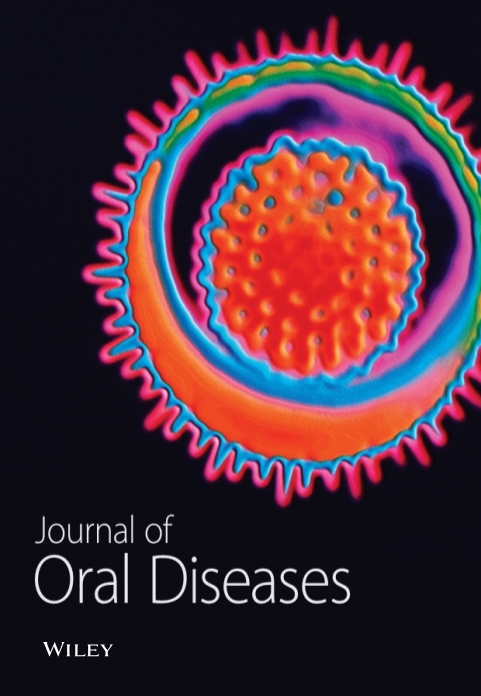口腔鳞状细胞癌中 Caspase-8 基因突变的预后影响
IF 2.9
3区 医学
Q1 DENTISTRY, ORAL SURGERY & MEDICINE
引用次数: 0
摘要
目的确定驱动基因并抑制其重要信号一直是癌症治疗的主要理念。方法在台湾收集了 120 例口腔鳞状细胞癌(OCSCC)患者及相应的病理标本。方法在台湾共收集了 120 例 OCSCC 患者及相应的病理标本,进行了全外显子组测序,并分析了每个基因对预后的影响。结果在台湾和TCGA队列中,caspase-8基因突变的发生率分别为22.1%和10.9%。在台湾队列中,caspase-8基因突变是影响OS最显著的独立基因,调整后的危险比(HR)([95% CI]:3.83 [1.84-7.99])。TCGA数据库也验证了这一点(HR [95% CI]:1.51 [1.00-2.29])。在台湾队列中,有或没有caspase-8突变的患者的5年OS分别为38.1% vs. 75.3% (p < 0.001) (HR [95% CI]: 3.264 [1.645-6.438]),而在TCGA队列中,有或没有caspase-8突变的患者的5年OS分别为26.1% vs. 49.0% (p = 0.048) (1.513 [1.001-2.288])。Caspase-8突变也分别与TNM分期I/II/III/IV的不良预后相关。Caspase-8突变是影响预后最重要的基因改变。本文章由计算机程序翻译,如有差异,请以英文原文为准。
Prognostic impact of caspase‐8 mutation in oral cavity squamous cell carcinoma
ObjectiveIdentifying the drive genes and inhibiting their significant signals were persistently the main concepts in cancer treatment. However, for oral cavity squamous cell carcinoma (OCSCC), the most influential genes for overall survival (OS) remain unclear.MethodsA total of 120 OCSCC patients with corresponding pathologic specimens were collected in Taiwan. Whole‐exome sequencing was done and the prognostic impact of each gene was analyzed. TCGA database was used to validate.ResultsThe incidences of caspase‐8 mutation were 22.1% and 10.9% in the Taiwan and TCGA cohort, respectively. In the Taiwan cohort, caspase‐8 mutation was the most significant independent for OS with an adjusted hazard ratio (HR) ([95% CI]: 3.83 [1.84–7.99]). It was validated by the TCGA database (HR [95% CI]: 1.51 [1.00–2.29]). The 5‐year OSs of the patients with or without caspase‐8 mutation were 38.1% vs. 75.3% (p < 0.001) (HR [95% CI]: 3.264 [1.645–6.438]) in the Taiwan cohort, and 26.1% vs. 49.0% (p = 0.048) (1.513 [1.001–2.288]) in the TCGA cohorts, respectively. Caspase‐8 mutation was also individually associated with poor prognosis for TNM stage I/II/III/IV, respectively. CASP8 R127* and R494*, defined as pathogenic mutations in ClinVar, were presented in both cohorts.ConclusionsCaspase‐8 mutation was the most significant genetic alteration impacting prognosis.
求助全文
通过发布文献求助,成功后即可免费获取论文全文。
去求助
来源期刊

Oral diseases
医学-牙科与口腔外科
CiteScore
7.60
自引率
5.30%
发文量
325
审稿时长
4-8 weeks
期刊介绍:
Oral Diseases is a multidisciplinary and international journal with a focus on head and neck disorders, edited by leaders in the field, Professor Giovanni Lodi (Editor-in-Chief, Milan, Italy), Professor Stefano Petti (Deputy Editor, Rome, Italy) and Associate Professor Gulshan Sunavala-Dossabhoy (Deputy Editor, Shreveport, LA, USA). The journal is pre-eminent in oral medicine. Oral Diseases specifically strives to link often-isolated areas of dentistry and medicine through broad-based scholarship that includes well-designed and controlled clinical research, analytical epidemiology, and the translation of basic science in pre-clinical studies. The journal typically publishes articles relevant to many related medical specialties including especially dermatology, gastroenterology, hematology, immunology, infectious diseases, neuropsychiatry, oncology and otolaryngology. The essential requirement is that all submitted research is hypothesis-driven, with significant positive and negative results both welcomed. Equal publication emphasis is placed on etiology, pathogenesis, diagnosis, prevention and treatment.
 求助内容:
求助内容: 应助结果提醒方式:
应助结果提醒方式:


